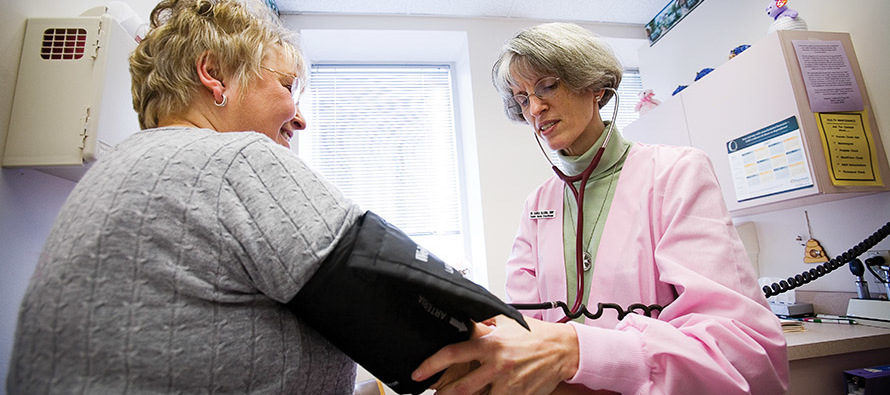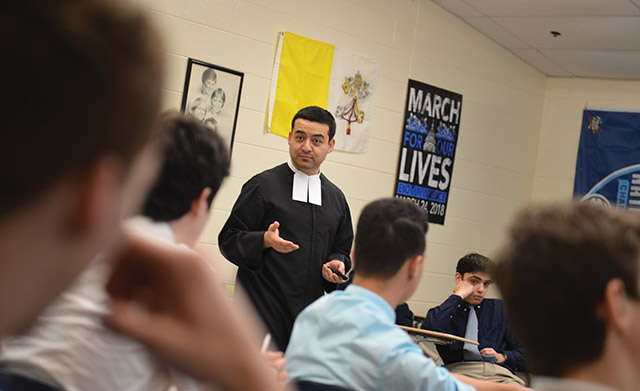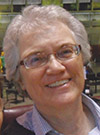Prayer set in motion

Sister Carole Blazina, S.C. performs a blood pressure check. (Photo courtesy of Sisters of Charity of Seton Hill.)
PRAYER, AS PROMPTED by the Holy Spirit, is our daily conversation with God. How we experience prayer each day ultimately leads us to God’s plan for our life. Then prayer becomes an integral part of our calling, no matter what it is.
When I look back at my call to religious life, I see that a number of influences moved me to begin the journey of discernment. Topping the list was my growing relationship with God and a sense of God inviting me to “more.” I sensed this invitation because I was open to a relationship with God and had been taking time to be with God through prayer.
My prayer life and how I experienced God in the everyday certainly influenced my discernment and ultimately the community I entered. I like adventure, and I felt called to service and to sharing my faith life like the disciples Jesus sent out into the world on mission. I imagined taking only the clothes on my back and the shoes on my feet! How and where I could do that took a while for me to discover. Eventually I entered a congregation whose prayer life, community, and mission centered on service and ministry in the world. It was a natural fit.
Contemplatives in action
Regardless of the style of community that attracts you, a call to religious life means putting God at the center of your life, which is true for every Christian calling. A prayer life anchors you in living out your call, your vows, and your daily life; without it, religious life does not make sense. Each style of religious life places importance on prayer—both communally and through private personal prayer. How prayer is integrated into the life of the community and the individual will vary according to the particular kind of religious life and the customs of the particular community.
Members of religious communities focused on service in the world like to think of ourselves as “contemplatives in action,” as Saint Ignatius of Loyola, the founder of the Jesuits, described his companions. That means we find God in the world in all people, places, and things, including our ministry.
Because we are called to respond to the pressing needs in the world around us, we take God with us and find God through our ministry. Within their work of teaching, social service, healthcare, and the many other forms of ministry, some of the ways that communities called to active service in the world pray both communally or individually are:
• The Liturgy of the Hours at most once or twice a day; also known as the Divine Office, consisting of psalms, a reading, intercessions, and other short prayers
• Special prayers composed for one’s community or about Mary, and Christ, among others
• Faith-sharing
• The Rosary
• Special community feast-day novenas (at least nine days of prayer)
• Theological reflection, for example, faith-sharing on experiences in ministry, community life, and other parts of religious life
• Eucharistic liturgy (Mass)
• Eucharistic Adoration
• Contemplation or “centering prayer” (prayer of quiet)
• Prayer of presence—finding God in the moment, among us and within others as we pray “on the go” while caring for or praying with those in need.

Prayer works
Prayer and action go hand-in-hand for active apostolic communities—and, indeed, for many committed laypersons. We are called to be people of prayer who find God through those we are called to serve. “Jesus called his disciples and sent them into the world to bring the Good News to every creature” (Mark 16:15). The church’s call to evangelization fits the active community’s call to mobility and availability to serve where most needed to do God’s work in all corners of the world.
Sister Angelique Geay, C.B.S.—a wise leader in the early days of the Sisters of Bon Secours—was animated by a deep faith and saw God in everything. She said we should refrain from traditional devotions in order to respond to the urgent need to care for others. We can feel free to leave our mental conversation with God to find God physically in the person we are called to serve. Our work is our prayer, too. We pray with others or silently in our heart. Although this prayer may not formally end with “amen,” it is an active prayer that shares God’s love with others as we do God’s work here on Earth. Before and after our service and prayer, we come together as a community using other forms of prayer.
A balancing act with God at the center
Striving for balance between prayer and ministry is challenging sometimes. For active communities, prayer without service, without action, can be an escape from the call to experience God in those we serve, while ministry without prayer can become addictive or even driven.
Active apostolic religious men and women, such as Sisters of Bon Secours or the Jesuits, are available and mobile for their mission and focus on service in the world. They strive for a balance of service and prayer.
Members of monastic communities, such as Benedictines, usually take a vow of “stability” and live their entire lives at a specific monastery. Their life focuses on common life, common prayer, and work. Varying by community, their work may be in or outside the monastery to which they return at day’s end.
Cloistered nuns and monks, such as the Trappists and some Carmelites, live and work solely in one place they rarely leave, practicing a more contemplative lifestyle centered on prayer for the world, silence, and solitude with some work like retreats, teaching, farming, and other activities. The main difference between these communities is that monastic and contemplative communities emphasize a life of prayer, and active apostolic communities focus more on service.
Being conscious of God in the moment of ministry is a gift. My head and heart know that God is within each person I am serving and that God is also ministering to me. My spiritual director, a Jesuit steeped in Ignatian spirituality, once suggested asking myself every couple of hours, “Where did I experience God in these past two or three hours?” Sometimes, I regretfully realized, I had never thought of God or I’d been so busy I had never even thought of the question. So I ask in prayer for the awareness of God’s presence. You would think after being a sister for so many years it would come easily! Thankfully God is very patient with me.
We all have different personalities—even in religious communities, each of us is unique—and we also have different gifts and preferences in how we communicate with and worship God. One of the wonderful things about living in an active community is that we can incorporate our favorite prayer style into our favorite ministry. Some of us are wired to relish those quiet moments we take in prayer with God each day, while others favor the joy we receive during harried moments in ministry and the praise we can immediately offer up in prayer. Just as many people reach for the cell phone in their pockets each place they go, we take our call to serve and prayers to God in our “pocket,” too, integrating it into all we do.
Religious communities have many ways to pray together and privately. My call is to share my gifts in service where there are great needs as a member of an active apostolic religious community. For those I minister to and with, do they experience or see that God is entering their lives through my ministry? Hopefully both my personal and community prayer life are bringing God alive as I follow in the footsteps of Jesus to bring healing, compassion, and liberation to a world in need as a Sister of Bon Secours.
A version of this article originally appeared in VISION 2014. Related article: VocationNetwork.org, “Prayer sustains my vocation.”
Tags
Related
- Questions Catholics Ask: What are the different forms of prayer?
- What does “success” look like in discernment?
- How to find a guide for your vocation adventure
- Beware of bots and bad actors as you engage online
- Call stories to help you discern
- Five reasons to pray the Liturgy of the Hours
- Tune into your prayer life
- Embody your decisions
- Your mission awaits you! Pope Francis' message to young people
- My portable prayer life Read More
Most Viewed
- Find your spirituality type quiz
- Questions and answers about religious vocations
- Celibacy quiz: Could I be a nun? Could I be a brother? Could I be a priest?
- Resources for older discerners or those with physical and developmental differences
- About Vocation Network and VISION Guide


 Sister Pat Dowling, C.B.S. belongs to the Sisters of Bon Secours. She served for more than 20 years in vocation ministry for her congregation at the national and international level. She lives in Baltimore.
Sister Pat Dowling, C.B.S. belongs to the Sisters of Bon Secours. She served for more than 20 years in vocation ministry for her congregation at the national and international level. She lives in Baltimore.